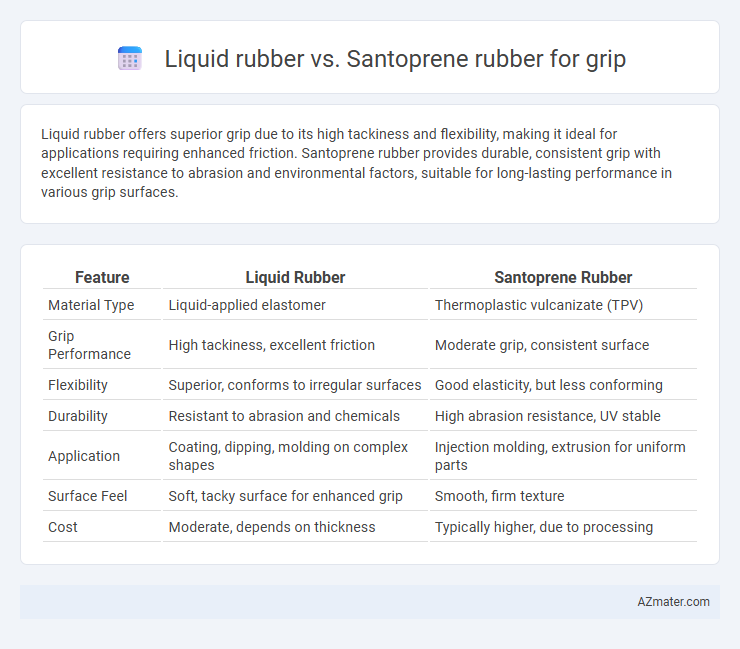Liquid rubber offers superior grip due to its high tackiness and flexibility, making it ideal for applications requiring enhanced friction. Santoprene rubber provides durable, consistent grip with excellent resistance to abrasion and environmental factors, suitable for long-lasting performance in various grip surfaces.
Table of Comparison
| Feature | Liquid Rubber | Santoprene Rubber |
|---|---|---|
| Material Type | Liquid-applied elastomer | Thermoplastic vulcanizate (TPV) |
| Grip Performance | High tackiness, excellent friction | Moderate grip, consistent surface |
| Flexibility | Superior, conforms to irregular surfaces | Good elasticity, but less conforming |
| Durability | Resistant to abrasion and chemicals | High abrasion resistance, UV stable |
| Application | Coating, dipping, molding on complex shapes | Injection molding, extrusion for uniform parts |
| Surface Feel | Soft, tacky surface for enhanced grip | Smooth, firm texture |
| Cost | Moderate, depends on thickness | Typically higher, due to processing |
Introduction to Liquid Rubber and Santoprene Rubber
Liquid rubber is a versatile, synthetic elastomer known for its excellent flexibility, waterproofing, and chemical resistance, making it ideal for enhancing grip in various applications. Santoprene rubber, a thermoplastic elastomer, combines the properties of rubber and plastic, providing superior durability, elasticity, and resistance to environmental factors that improve grip performance. Both materials are widely used in grips, with liquid rubber offering customizable coatings and Santoprene delivering long-lasting, moldable grip solutions.
Chemical Composition and Structure
Liquid rubber, typically composed of nitrile or silicone polymers, exhibits a flexible, amorphous structure that enhances its adhesive grip properties through excellent elongation and recovery. Santoprene rubber is a thermoplastic elastomer blending polypropylene and vulcanized rubber, combining the elasticity of rubber with the processability of plastics, resulting in durable, slip-resistant grips. The chemical composition of liquid rubber allows for superior chemical resistance and moisture sealing, whereas Santoprene's co-polymeric matrix provides enhanced thermal stability and mechanical robustness for sustained grip performance.
Manufacturing Processes Compared
Liquid rubber offers superior surface adhesion and curing versatility in manufacturing through processes like dip molding and casting, enabling precise grip textures and seamless coatings. Santoprene rubber benefits from advanced thermoplastic vulcanizates (TPV) manufacturing, such as injection molding and extrusion, which produce consistent grip parts with high durability and flexibility. Both materials provide grip solutions, but liquid rubber excels in custom surface finishes, while Santoprene ensures efficient mass production with enhanced mechanical properties.
Grip Performance and Surface Texture
Liquid rubber offers superior grip performance due to its high tackiness and seamless application, creating a smooth yet highly adhesive surface ideal for firm hold in wet or dry conditions. Santoprene rubber provides excellent durability with a slightly textured surface, enhancing grip by increasing friction and resistance to wear over time, making it suitable for repeated use in dynamic environments. The choice between liquid rubber and Santoprene depends on whether immediate tacky grip (liquid rubber) or long-lasting textured traction (Santoprene) is prioritized.
Durability and Wear Resistance
Liquid rubber offers superior wear resistance due to its flexible, sealing properties that prevent cracking and abrasion over time, making it ideal for high-friction grip applications. Santoprene rubber combines thermoplastic elastomer benefits with excellent durability, providing consistent performance under cyclic stress and resistance to environmental factors. For grip durability, Liquid rubber excels in adhesion and flexibility, while Santoprene delivers long-term wear resistance and recovery from deformation.
Chemical and Environmental Resistance
Liquid rubber exhibits superior chemical resistance, effectively withstanding exposure to oils, solvents, and acids, making it ideal for applications requiring durable grip under harsh conditions. Santoprene rubber offers excellent environmental resistance, maintaining flexibility and grip performance despite UV radiation, temperature fluctuations, and ozone exposure. Both materials provide strong grip solutions, but liquid rubber excels in chemical environments, while Santoprene is preferred for outdoor or fluctuating environmental conditions.
Flexibility and Elasticity
Liquid rubber offers superior flexibility and elasticity due to its ability to form seamless, pliable coatings that conform closely to various surfaces, enhancing grip performance. Santoprene rubber, a thermoplastic elastomer, provides durable elasticity with excellent resistance to compression set, maintaining grip integrity over extended use. When prioritizing flexibility and elastic recovery, liquid rubber typically outperforms Santoprene in applications requiring dynamic surface adaptability.
Cost Efficiency and Availability
Liquid rubber offers superior cost efficiency due to lower material and application expenses compared to Santoprene rubber, which demands higher processing costs. Availability of liquid rubber is widespread, with numerous suppliers providing various formulations suited for grip applications, whereas Santoprene's availability is more limited, often sourced from specialized manufacturers. For grip enhancement, liquid rubber's cost-effective versatility and broader market presence make it a preferred choice over Santoprene rubber.
Common Applications for Grip Enhancement
Liquid rubber offers superior adhesion and flexibility, making it ideal for custom grip coatings in tools, sports equipment, and electronic devices where tactile control is crucial. Santoprene rubber combines thermoplastic elastomer properties with excellent durability, widely used in automotive steering wheels, wearable devices, and industrial grips requiring both comfort and resilience. Common applications for grip enhancement leverage liquid rubber's conformability for precise textures, while Santoprene excels in mass-produced components demanding consistent performance and weather resistance.
Choosing the Right Material for Your Needs
Liquid rubber offers excellent grip due to its high tackiness and adaptability, making it ideal for custom-shaped handles and intricate designs. Santoprene rubber provides durable, consistent grip with superior resistance to wear, chemicals, and temperature variations, suitable for industrial or heavy-use applications. Choosing between them depends on whether you need flexible, moldable grip solutions or long-lasting, rugged performance for your specific demands.

Infographic: Liquid rubber vs Santoprene rubber for Grip
 azmater.com
azmater.com